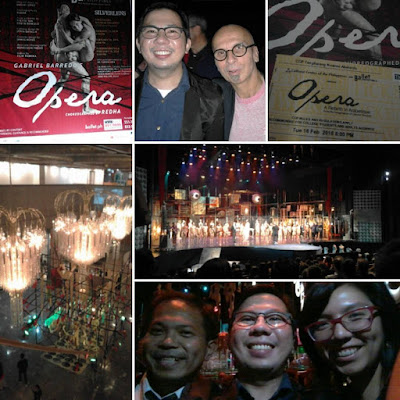From the moment that I set foot at the Main Lobby of the Cultural Center of the Philippines, I couldn’t help but be awed by the scale and especially by the grotesqueness and eeriness of the sculptures by Gabriel Barredo that greeted me. Mannequins each bearing a unique alteration and/or mutilation rendered them not quite human. And being the inanimate objects that they are, they emitted a sense of harsh coldness. Without a doubt, I’ve already stepped into the world of Opera, Ballet Philippines’ closing production for their 46th Dance Spring Season.
Once inside the theater, I thought that I would be overwhelmed
by the set pieces on the much larger stage. But, choreographer Redha opted to
start the ballet almost in total darkness with just a lone dancer, Death
(Denise Parungao) fluidly moving underneath a set piece of a womb bearing
twins. Soon enough, The Mother (Carissa Adea) pregnant with twins enter the
stage. And with the subsequent birth of The Twins (Victor Maguad and Erl
Sorilla), so did the stage light up revealing the intricate pieces assembled on
stage that dwarfed the one at the lobby.
One by one, the dancers started to emerge from the sets as if the artworks were being brought to life. This spark of life was such a direct contrast from the inanimate coldness that I felt before. But there was a catch, the life that flows through these Imperfect Creations is flawed and the movements were jolty, clumsy, and spastic. And as if Redha is sticking to a theme of contrasts, the movements of The Watcher (Jean Marc Cordero) and his eyes were more deliberate and finished.
One of the most striking contrasts were seen during Act II,
entitled Sex. The first such act involved the younger Twin (Erl) character with
the Homunculus (Earl John Arisola) which was violent, further highlighted by
the pounding pulse of the music and the flood of vibrant red lights. While when
the older Twin (Victor) did it with one of The Watcher’s eyes, it was a lot
tender accompanied by lyrical strings and bathed with softer lights.
While all this was happening, I was always drawn to Death
who has never looked so alluring and tempting. It puzzled me when I saw her
shadowing the movements of The Homunculus earlier on and then doing the same
with The Mother during the latter part. I had to ask Redha what those movements
meant. Was Death mimicking the others or was she the one pulling the strings
all the while? And when Death claimed The Mother, all the frantic, complex and
intricate dancing calmed down. From it, came a funeral procession that was very
orderly and peaceful. When I caught up to Redha after the show, he said that
the shadowing movements is but a reminder that Death is just around the corner.
And for the funeral march that had the most sense of order throughout the whole
ballet, Redha responded cryptically that Death is the most natural thing in the
world.
I came in to the theater anticipating Gabriel Barredo’s art
brought to life by the Ballet Philippines dancers. And what a life they brought
to the stage. As for the music by Malek Lopez, the insistent pulse, sometimes
calm and at times racing, was like the blood pumping through the veins of the
body. But it was still Death that mesmerized me. Gabriel Barredo’s Opera showed
that having Death lingering around makes me see what Life is all about more
clearly.




No comments:
Post a Comment